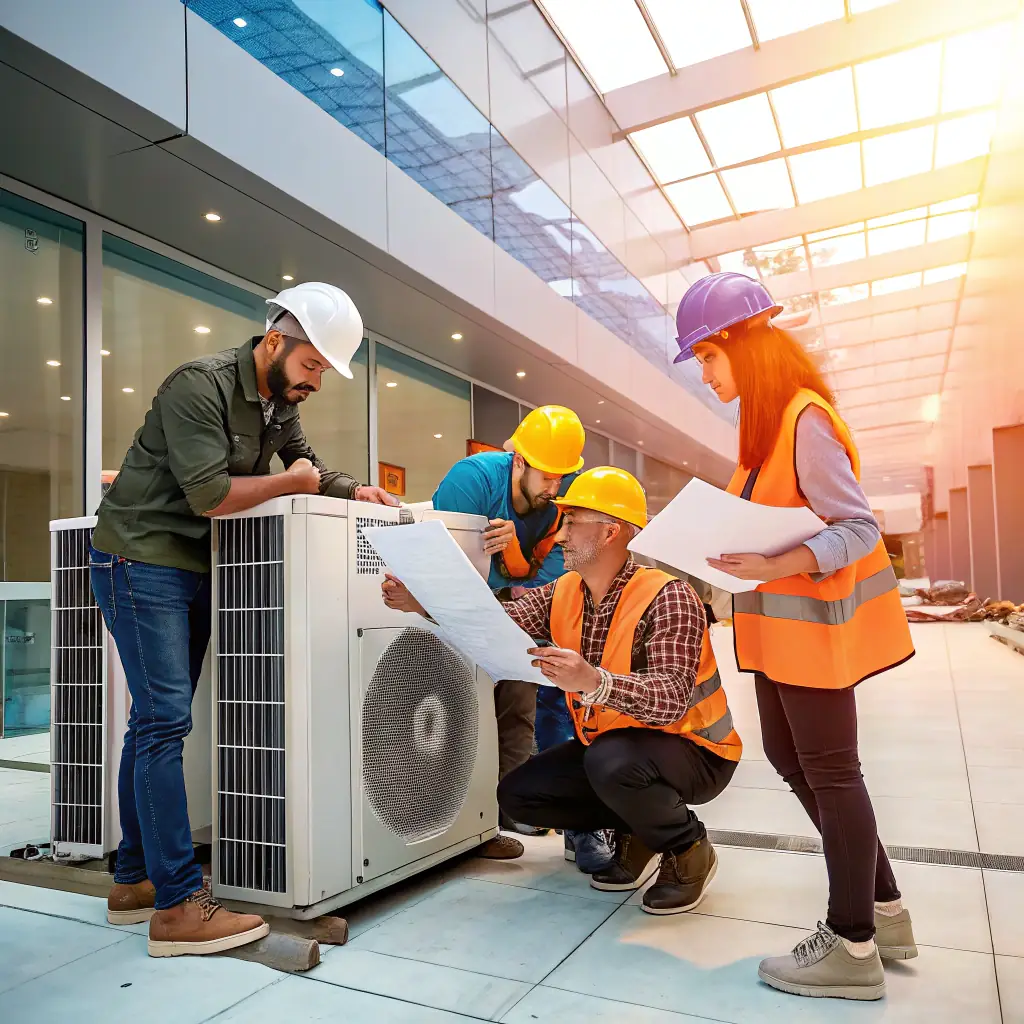Why is there a labor shortage in the HVAC industry, and how can we advocate for skilled
trade careers to meet growing demands?
Letter of Introduction
Dear Readers,
Thank you for taking the time to visit my project website, which advocates for more support of skilled labor jobs. specifically within the HVAC industry. When I originally proposed this project, I planned to focus on how automation and AI were reshaping the HVAC workforce and how to adapt to these inevitable changes. However, after conducting research and interviewing local professionals, my focus shifted. I now believe the most urgent issue is the growing shortage of skilled HVAC workers. This shortage is due to many factors, primarily the retirement of older generations and a lack of new workers entering the field. Before preparing people for changes caused by automation it is imperative that the HVAC industry has enough skilled workers in the first place.
This website is aimed to help high school students who are exploring career options, advocates for the HVAC workforce, educators, guidance counselors, and various community leaders who influence both funding and the public perception of vocational and skilled careers. Too often the public is influenced to believe that a four-year college education is the only way forward, it’s time to stop overlooking imperative trade jobs such as HVAC. By targeting and educating this audience I hope to not only change the narrative surrounding blue collar work but also to inform about these essential careers which offer stability and a good livelihood. Lastly, I also hope to help communities take real life action and steps forward to not only strengthen their local infrastructure but economy too.
I believe a website as the medium for this composition will be the most impactful because it is flexible, accessible, and allows for informational multimedia content. This website is able to be updated to stay current with the times and can be very easily shared across social media, allowing this pertinent information to reach the broadest audience. Unlike other mediums, this format will visually emphasize the urgency of the labor shortage while offering information and resources to those looking to support or pursue a career in HVAC.
My thesis is transparent and concise: We need to invest in and advocate for labor jobs like HVAC because retirements are outpacing recruitment, creating an urgent workforce gap that threatens public infrastructure and economic stability. This project aims to address several points: 1. HVAC is essential to both public health and safety due to Nevada’s extreme climate. 2. Many current workers are nearing retirement age, creating further strain on the HVAC industry. 3) The cultural stigma against blue-collar jobs is actively deterring young adults from entering the trades. 4. Policy, funding, and education systems often prioritize college pathways over vocational routes. 5. Increasing enrollment in HVAC programs benefit not only the individuals in the programs but the economy and community as well.
Overall, this website is designed to raise awareness, shift perceptions, and offer tangible solutions to address the labor crisis. I aim to inspire the next generation to no longer view HVAC, and other trades, as a back up plan but instead as a valuable, lucrative, and respected career path. I hope this composition encourages not only meaningful discussion but measurable action as well, such as increased funding for vocational programs, community partnerships, and an overall bigger outreach to the youth, our future.
Sincerely,
Nicolas Johnson

Why is there a labor shortage in the HVAC industry?
The HVAC (Heating, Ventilation, and Air Conditioning) industry is facing a severe labor shortage. This impacts service availability and project timelines. It is imperative that the root causes of this issue is understood so that it can be addressed, primarily through attracting new talent to the field.
- Retirement is shrinking the workforce, it's evident that a significant portion of HVAC workers are nearing retirement. According to ServiceTitan, nearly 25% of skilled trade professionals, including HVAC techs, are over the age of 55. Experienced workers are leaving the field, fast. Unfortunately, not enough new technicians are joining the field to replace them. The result of this is that many companies are struggling to meet the demand of their services while training and recruiting new replacements (ServiceTitan).
- Less and less young adults are entering blue-collar fields as they are oftentimes being encouraged to pursue a college degree instead of the trade. This is resulting in lowered interest in HVAC careers, Raiven explains here that a multitude of students never consider a career in HVAC because it's not often promoted as a high-opportunity career. These misconceptions surrounding pay, stability, respect, and advancement tend to turn people away, even though the industry truly does offer strong benefits and stability (Raiven).
- The aging workforce is leading to increased retirements, especially as a substantial portion of the current HVAC workforce approaches retirement age. According to ACHR News, approximately 25,000 HVAC techs are exiting the workforce each year. This number dwarfs the number of techs entering the workforce, indicating a looming gap in skilled labor fields which could exceed 100,000 workers in the coming years (Helios).


How can we attract and develop more HVAC technicians?
With tens of thousands of HVAC positions going unfilled nationwide, it’s critical to implement strategies that both recruit new talent and develop them into skilled professionals. Below are some evidence‑based approaches:
- Building and advertising both training and apprenticeship programs have proven to be one of the most effective ways to solve the labor shortage, accessible training programs are a necessity. According to Helios Service Partners, HVAC companies should invest in on the job learning through apprenticeships and mentorships. These programs increase accessibility by allowing new technicians to simultaneously learn and work, overall reducing both financial and time burdens that traditional schools imposes. It is also emphasized that employers who utilize internal training create not only loyalty but also a direct supply of workers who are specialized in meeting the exact needs of their company (Helios).
- Another key component in addressing the labor shortage is partnering with schools to promote trades, this increases awareness of HVAC and other technical careers but also helps to de-stigmatize blue collar work. Raiven reports that many young people don't consider trade careers simply because they're not introduced to them early enough. HVAC contractors can work directly with schools to offer assemblies, classroom visits, summer internships, and even scholarship opportunities. By offering programs and support like this students can be shown that HVAC is a respected, modern, lucrative, and tech-driven field, overall helping companies to recruit more from the next generation (Raiven).
- Improving pay, benefits, and career advancement have also proven to be an effective strategy in combatting the labor shortage. A ServiceTitan industry report states that competitive compensation and clear career paths are essential for both attracting and retaining HVAC talent. By offering higher starting wages, paid certification opportunities, defined promotion paths, and flexible scheduling careers in the HVAC industry can be made much more appealing. When employees know there is room to grow and be rewarded in their roles they will be much more likely to stay longer, work harder, and even refer others. When companies adapt these practices they are not only working to solve the shortage but also creating a better work culture (ServiceTitan).
Why skilled trades are the backbone of our economy
Skilled trades form the foundation of our economy, driving growth, innovation, and resilience across various sectors. From infrastructure development to renewable energy projects, tradespeople play a crucial role in shaping our nation’s future.
- Skilled trades are essential for growth of both the economy and infrastructure. As detailed in BOSS Magazine, tradespeople such as HVAC techs, electricians, plumbers, and welders are integral in maintaining the infrastructure of communities and even enabling other industries to prosper. The work tradespeople do helps to ensure that everything from homes to factories to stores operate smoothly, therefore encouraging the local economy to grow and remain stable (BOSS).
- The skilled trades are about more than manual labor, they drive innovation and are at the forefront of adaption to technical advances. Tradespeople are required to learn and grow as they operate, program, and maintain advanced machinery and systems, especially those that are used in renewable energy and smart manufacturing. The required adaptability of these workers ensure that the trades industries, especially HVAC, remain relevant and continue to contribute towards economic growth (Forbes).

Works Cited
Works Cited
“How HVAC Contractors Can Combat the HVAC Talent Shortage.” Raiven, 6 Dec. 2022, www.raiven.com/blog/how-hvac-contractors-can-combat-the-hvac-talent-shortage. Accessed 9 May 2025.
“HVAC Industry Continues to Deal With Labor Shortage.” ACHR News, 3 Feb. 2023, www.achrnews.com/articles/148429-hvac-industry-continues-to-deal-with-labor-shortage. Accessed 9 May 2025.
“HVAC Labor Shortage: Why It’s Happening and What to Do.” ServiceTitan, 8 Sept. 2023, www.servicetitan.com/blog/hvac-labor-shortage. Accessed 9 May 2025.
“HVAC Statistics: The Data You Need to Know for 2025.” ServiceTitan, 3 Jan. 2025, www.servicetitan.com/blog/hvac-statistics. Accessed 9 May 2025.
“The Economic Impact of Trade Professions in 2024.” BOSS Magazine, 1 Mar. 2024, thebossmagazine.com/the-economic-impact-of-trade-professions-in-2024. Accessed 9 May 2025.
“The Importance of Skilled Trades in Shaping the Future of Work.” LinkedIn Pulse, Flexie Inc., 15 Feb. 2024, www.linkedin.com/pulse/importance-skilled-trades-shaping-future-work-goflexie-c2pze. Accessed 9 May 2025.
10Web AI. AI-generated image used in HVAC workforce shortage website. 10Web, 9 May 2025. Accessed 9 May 2025